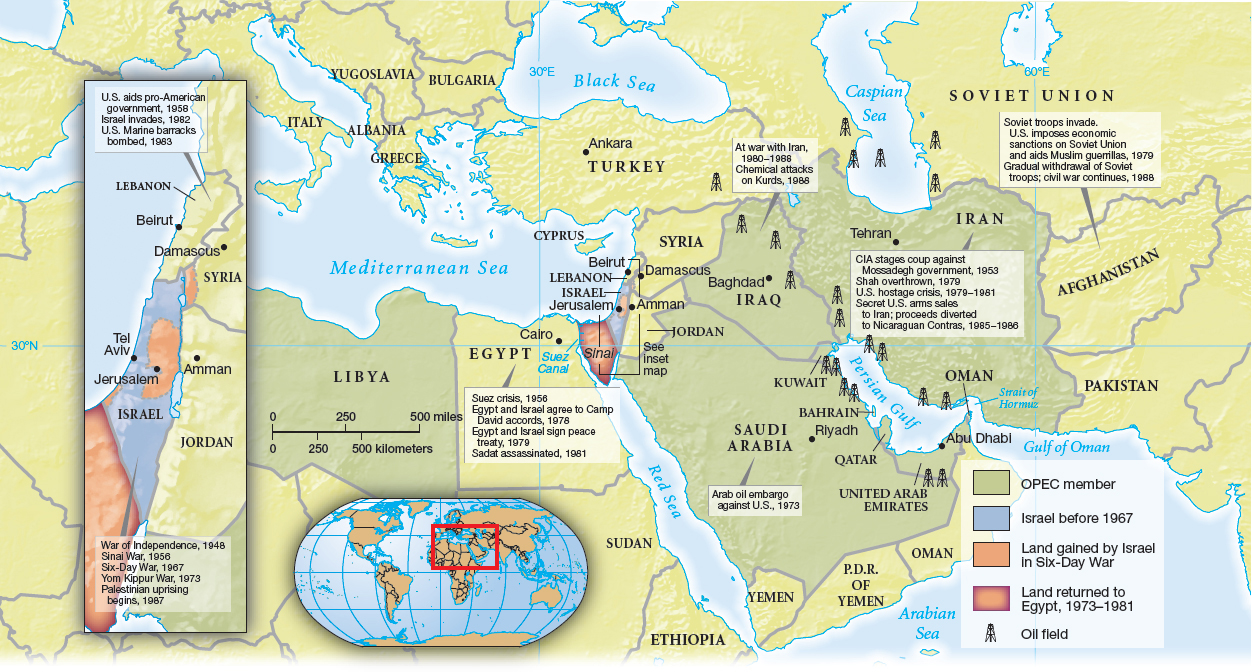Promoting Human Rights Abroad
Printed Page 909
Section Chronology
“We’re ashamed of what our government is as we deal with other nations around the world,” Jimmy Carter charged, promising to reverse U.S. support of dictators, secret diplomacy, interference in the internal affairs of other countries, and excessive reliance on military solutions. Human rights formed the cornerstone of his approach. The Carter administration applied economic pressure on governments that denied their citizens basic rights, refusing aid or trading privileges to nations such as Chile and El Salvador, as well as to the white minority governments of Rhodesia and South Africa. Yet in other instances, Carter sacrificed human rights ideals to strategic and security considerations, invoking no sanctions against repressive governments in Iran, South Korea, and the Philippines.
Carter’s human rights principles faced another test when a popular movement overthrew an oppressive dictatorship in Nicaragua. U.S. officials were uneasy about the leftist Sandinistas who led the rebellion and had ties to Cuba. Once they assumed power in 1979, however, Carter recognized the new government and sent economic aid, signaling that the way a government treated its citizens was as important as how anti-Communist and friendly to American interests it was.
Applying moral principles to relations with Panama, Carter sped up negotiations over control of the Panama Canal and in 1977 signed a treaty providing for Panama’s takeover of the canal in 2000. Supporters viewed the treaty as restitution for the U.S. seizure of Panamanian territory in 1903. Opponents insisted on retaining the vital waterway. “We bought it, we paid for it, it’s ours,” claimed Ronald Reagan during the presidential primaries of 1976. It took a massive effort by the administration to get Senate ratification of the Panama Canal treaty.
Panama Canal treaty
 1977 agreement that returned control of the Panama Canal from the United States to Panama in 2000. To pass the treaty, President Carter overcame stiff opposition in the Senate from conservatives who regarded control of the canal as vital to America’s interests.
1977 agreement that returned control of the Panama Canal from the United States to Panama in 2000. To pass the treaty, President Carter overcame stiff opposition in the Senate from conservatives who regarded control of the canal as vital to America’s interests.
Seeking to promote peace in the Middle East, Carter seized on the courage of Egyptian president Anwar Sadat, the first Arab leader to risk his political career by talking directly with Israeli officials. In 1979, Carter invited Sadat and Israeli prime minister Menachem Begin to Camp David, Maryland, where he applied his tenacious diplomacy for thirteen days. These talks led to the Camp David accords, whereby Egypt became the first Arab state to recognize Israel, and Israel agreed to gradual withdrawal from the Sinai Peninsula, which it had seized in the 1967 Six-Day War (Map 30.2). Although the issues of Palestinian self-determination in other Israeli-occupied territories (the West Bank and Gaza) and the plight of Palestinian refugees remained unresolved, Carter had nurtured the first meaningful steps toward peace in the Middle East.
Camp David accords
 Agreements between Egypt and Israel reached at the 1979 talks hosted by President Carter at Camp David. In the accords, Egypt became the first Arab state to recognize Israel, and Israel agreed to gradual withdrawal from the Sinai Peninsula.
Agreements between Egypt and Israel reached at the 1979 talks hosted by President Carter at Camp David. In the accords, Egypt became the first Arab state to recognize Israel, and Israel agreed to gradual withdrawal from the Sinai Peninsula.
CHAPTER LOCATOR
How did the Nixon presidency reflect the rise of postwar conservatism?
Why did the “outsider” presidency of Jimmy Carter fail to gain broad support?
What conservative goals were realized in the Reagan administration?
What strategies did liberals use to fight the conservative turn?
How did Ronald Reagan’s foreign policy affect the Cold War?
Conclusion: What was the long-term impact of the conservative turn?
 LearningCurve
LearningCurve
Check what you know.
